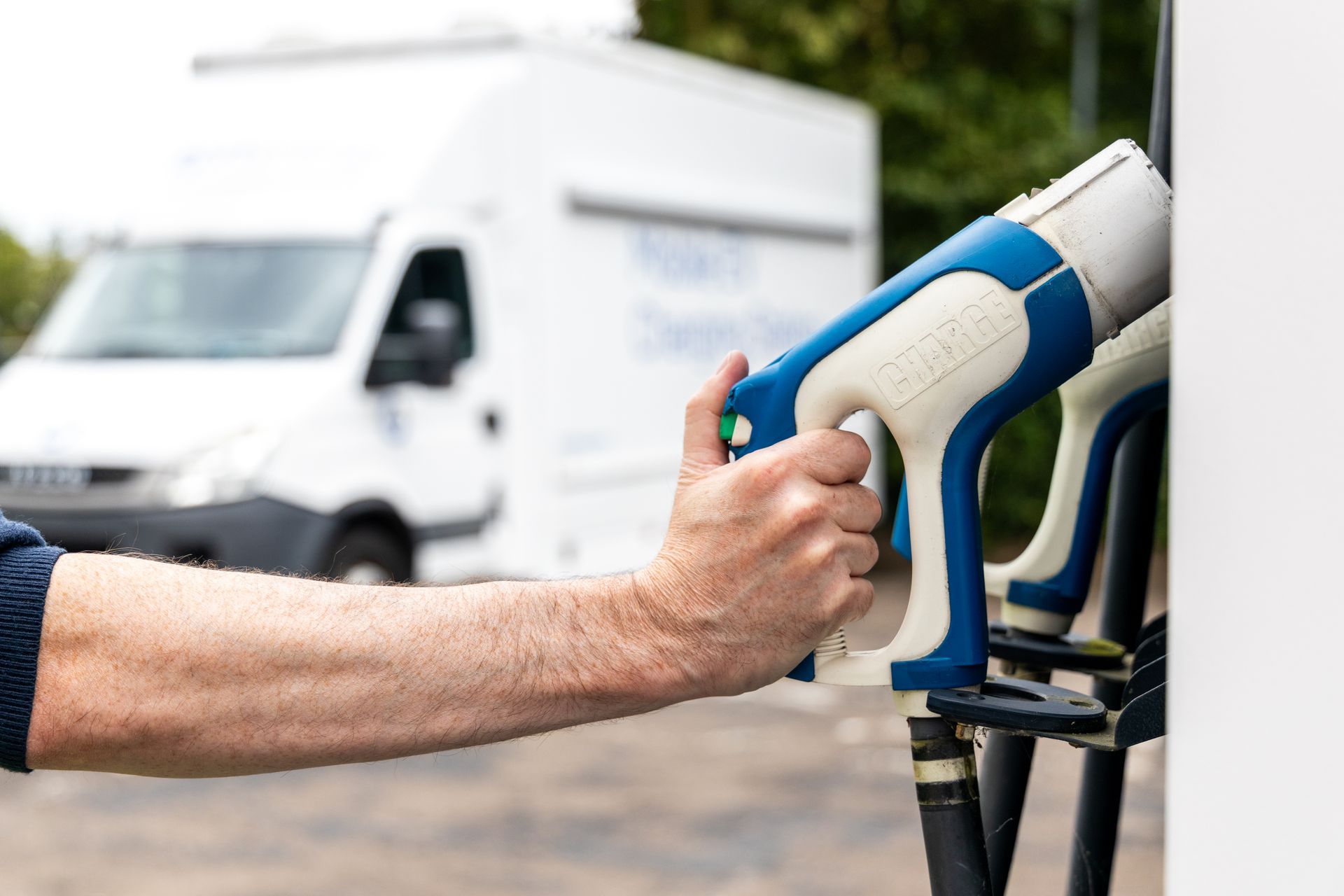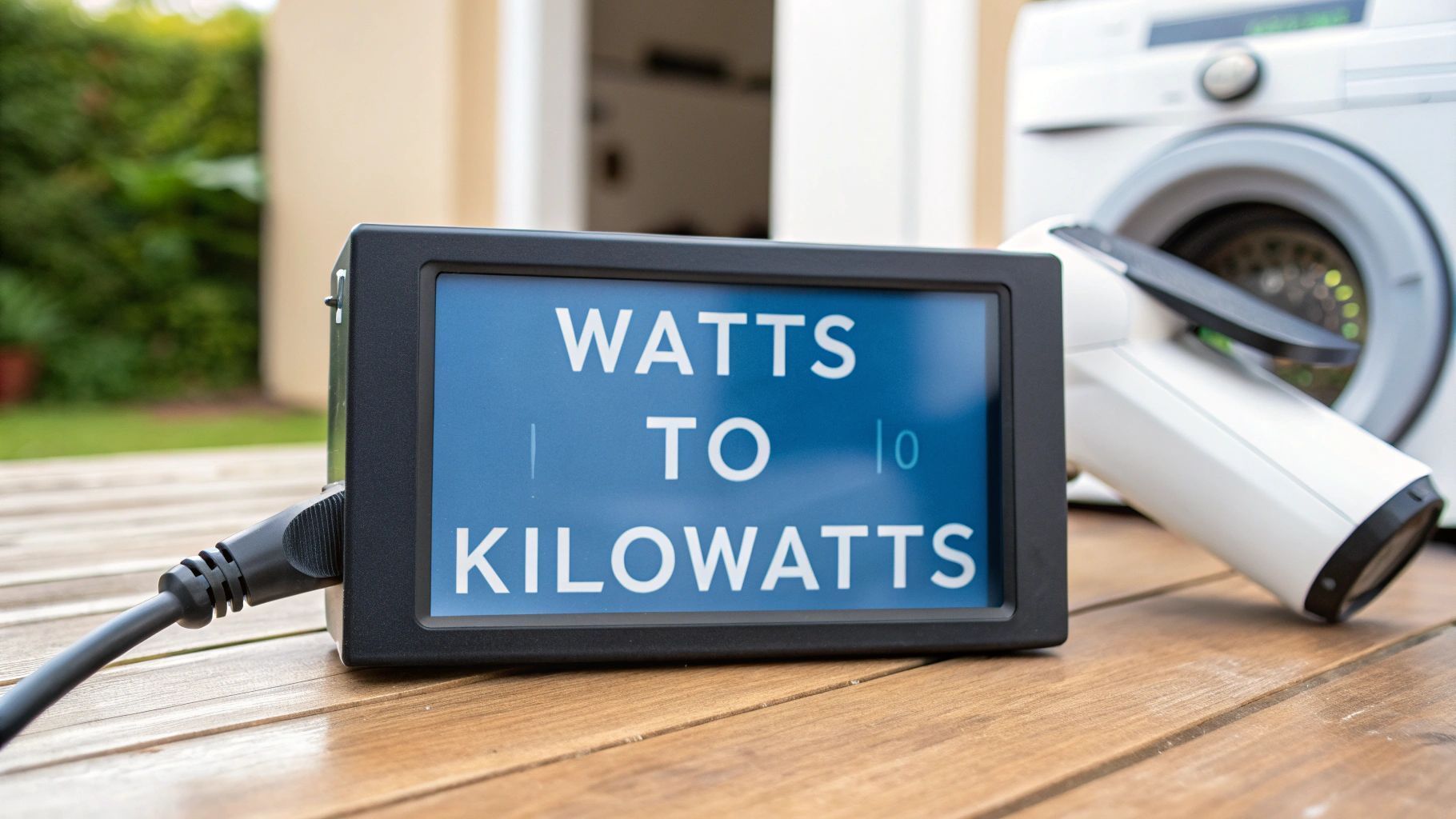How to Install an EV Charger in the UK
Getting an EV charger installed at home is a lot more straightforward than you might think. It really boils down to four key stages: picking the right charger, getting your home's electrics checked out, hiring a certified pro to fit it and then doing the final safety checks. For most of us in the UK, following this path ensures everything is safe, compliant and ready for easy overnight charging.
Your Guide to Home EV Charger Installation

Jumping into a home EV charger installation can feel like a big project but it doesn't have to be. This guide is here to break it all down, taking you through everything from choosing the best charger for your car and home to making sure all the electrical work is handled safely.
We’ll look at the different models available here in the UK, from the standard 7kW units that are perfect for overnight top-ups, to more powerful chargers for those who need to get back on the road faster. It's also vital to understand your home’s current electrical setup, so we'll cover what you and your installer need to look for before any work starts.
The Growing Need for Home and Mobile Charging
As more of us switch to electric vehicles, the demand for reliable charging is exploding. The growth in EV charger installations across the UK has been dramatic, showing a real commitment to supporting the shift. As of June 2025, the UK had installed 82,369 public charging devices , a massive 30% increase from the previous year. You can dig into more of this data in Willow Leasing's report on EV charging numbers in the UK.
This rapid expansion really highlights something important for new EV owners: while the public network is getting better, nothing beats the convenience and cost-effectiveness of charging at home. Having your own unit means you can plug in overnight, make the most of cheaper off-peak electricity tariffs and wake up to a full battery every single day.
Beyond the convenience of a fixed home charger, an entirely new and profitable field is opening up: mobile charging. For entrepreneurs, running a mobile charging service is a fantastic business opportunity, offering on-demand power to drivers wherever they might be.
Understanding Your Options and Earning Potential
A good installation always starts with good information. Before anything gets wired up, you need to know which type of connector your car uses. Our detailed article on electric car charging plugs is a great place to get a clear overview of what you'll encounter.
While this guide focuses on home setup, it is worth acknowledging the immense advantages of mobile charging. For those with an entrepreneurial spirit, operating a mobile charging service is a lucrative venture. The business model is simple yet highly effective and allows an operator to earn a significant income. A typical revenue structure includes:
- A standard call-out fee for reaching a stranded vehicle.
- A per-kWh rate for the electricity provided.
- Subscription plans for businesses or frequent users needing regular top-ups.
This model provides a much-needed service to a growing market of EV drivers who require flexible charging solutions. And before you start any project, it’s always a good idea to check out a guide on the essential tools for homeowners to make sure you're properly equipped.
Planning Your Installation and Getting Approval
Before an installer even thinks about knocking on your door, a little bit of forward planning can make the entire process of installing an EV charger smoother, faster and cheaper. Taking the time to properly size up your property and understand what’s needed means you’ll be fully prepared for the work ahead.
The first practical step is pinning down the best location for your charge point. Every property is different but the goal is always the same: find a spot that’s convenient for you and practical for the installer. Think about where you normally park your EV and how easily a charging cable will reach from that position.
The ideal location keeps the cable run from your consumer unit (or fuse box) to the charger itself as short as possible. A shorter run is less expensive and involves less disruption. Common spots include inside a garage, on an exterior wall of your house or mounted on a dedicated post on your driveway.
Assessing Your Property and Power Needs
Once you have a location in mind, the next thing to consider is your home's electrical system. A 7kW home charger, the most common type, is a significant electrical load—similar to an electric shower or oven. Your existing setup absolutely must be able to handle this extra demand safely.
An installer will carry out a detailed survey but you can do a quick initial check yourself. Take a look at your consumer unit. Does it have spare capacity for a new, dedicated circuit? Is it a modern unit with RCD protection? If it looks old or is already full to the brim, you might be looking at an upgrade.
Your installer will also check your main fuse and the supply cable coming into your property. This determines the maximum load your home can draw from the grid. In some cases, particularly in older properties, this may need upgrading, which is a job that involves your Distribution Network Operator (DNO).
The infographic below gives you a clear visual of this initial planning sequence, from choosing a spot to getting the necessary checks and approvals sorted.

As you can see, a successful installation is really just a chain of logical steps, starting with a simple site assessment and ending with the official green light.
Navigating Regulations and Grants
In the UK, installing an EV charger is classed as 'notifiable work' under building regulations, which means your installer is responsible for handling all the paperwork. For most standard installations, they can self-certify their work.
A crucial part of this process is notifying your local Distribution Network Operator (DNO) —the company that manages the electricity grid in your area. Before any work begins, your installer will submit an application to ensure the grid can support the new charger. Don't worry, this is a standard procedure and is usually straightforward.
"Getting DNO approval is a non-negotiable step. It's a safety measure that protects not only your home's electrical system but also the stability of the local grid for you and your neighbours. A certified installer will manage this for you as part of their service."
Fortunately, the government provides financial help to make home charging more accessible. The Office for Zero Emission Vehicles (OZEV) offers grants that can subsidise up to 75% of the cost of installing a charge point, capped at £350 per installation . This scheme has already supported a huge number of homeowners—official statistics show well over 100,000 grants have been approved since 2020 . This kind of financial support is essential for overcoming the initial cost barrier. You can read more in the government's official electric vehicle charging infrastructure statistics.
These grants can significantly reduce your upfront expense, making the decision to get a home charger installed that much easier. If you're exploring ways to cover the remaining costs, our guide on finance for EV chargers offers some valuable insights. It’s always a good idea to check your eligibility for OZEV grants with your chosen installer, as the criteria can sometimes change.
What to Expect on Installation Day
So, the big day is here. Knowing what actually happens during the installation can make the whole process feel much smoother. When your certified electrician arrives, they won't just start drilling holes; they follow a very specific set of procedures to keep you and your property safe, ensuring your new charger works flawlessly from the get-go.
Let's walk through the key steps so you know exactly what’s going on.

The very first thing the installer will do is head to your consumer unit (or fuse box) to safely shut off your mains power. This is an absolutely critical safety measure. It’s a good idea to plan for a few hours without electricity, so make sure laptops are charged and you've got your kettle ready for when the power comes back on!
Once everything is safely powered down, the real electrical work begins. This is where the installer’s training and expertise are put to the test.
Creating a Safe and Dedicated Circuit
You can't just plug an EV charger into a standard wall socket. It needs its own dedicated circuit, running straight from the consumer unit. This is non-negotiable for safety and is required by regulations as it ensures the charger can handle a high, continuous electrical load without putting your home's system at risk.
To do this, the installer will fit a new protective device in your consumer unit. This is usually a Type A RCBO (Residual Current Circuit Breaker with Overload Protection) . Think of it as an incredibly smart fuse that not only protects against power surges but also detects minuscule earth fault currents, tripping the power in milliseconds to prevent any risk of electric shock.
This dedicated circuit with its own RCBO is probably the single most important safety feature of the whole installation. It completely isolates the charger from the rest of your home’s wiring. That means a fault with the charger won’t trip the lights in your house and a problem elsewhere won't knock out your car charger.
Running the Cable and Mounting the Unit
With the new circuit ready, the next task is to run the cable from the consumer unit to your chosen charger location. For any outdoor installation, this means using Steel Wire Armoured (SWA) cable. It’s tough stuff, designed to withstand the British weather and any accidental knocks. The installer will clip it neatly to the wall, making sure the route is tidy and secure.
Next, the charger itself gets mounted to the wall at a convenient height. The installer will drill into the wall, fit the mounting bracket and attach the unit securely. Finally, they'll connect the armoured cable to the charger’s internal terminals.
Proper earthing is another crucial step that must comply with UK wiring regulations ( BS 7671 ). Depending on your property’s existing electrical setup, your installer will use one of several approved methods to make sure the charger is correctly earthed, which is vital for preventing electric shock.
Understanding the Evolving Charger Landscape
While most home installations involve 7kW units, it’s interesting to see how the wider UK public network is evolving. In the first half of 2025 alone, the number of ultra-rapid chargers ( 150kW and above) shot up by 23% . For the first time, there are now more of these ultra-rapid points than standard rapid chargers.
Even with this shift, almost 80% of the UK’s public charging points are still lower-powered devices, showing a balance between the need for speed on motorways and the affordability of slower chargers for home and destination use. You can dive deeper into these trends in the latest EV charging infrastructure growth report.
Once all the physical work is done, your installer will perform a series of electrical tests before switching your power back on. This final check is to confirm that everything has been wired correctly, is safely earthed and operates exactly as it should. Only then is the job signed off as complete.
Unlocking Earnings with Mobile EV Charging
While having a fixed charger at home is a game-changer, the world of EV charging doesn't stop at the end of your driveway. There's a huge and growing opportunity in mobile EV charging—a service that brings the power right to the driver, wherever they might be. This 'charging-on-demand' model is fast becoming a crucial part of the UK's green economy.
This whole approach tackles one of the biggest headaches for EV drivers head-on: range anxiety. Think about it. A driver is stuck at the office, a shopping centre or even on the side of the road with a dangerously low battery and no fixed charger nearby. A mobile charging service isn't just a convenience; it's an essential lifeline, offering a quick fix that static infrastructure just can't match.
For an entrepreneur, this is a chance to get into a high-demand market with a flexible, scalable business. Forget the long, drawn-out process of installing fixed commercial chargers which can take months or even years with all the planning, permits and grid connections. A mobile charging operation can be up and running surprisingly quickly.
The Business Model Behind Mobile Charging
At its heart, a mobile charging business is a service built around convenience. You're using powerful, portable DC fast charging equipment—often carried in a van—to give customers a rapid top-up when they need it most. To make it work, you need a clear and profitable pricing structure that truly reflects the value of this on-demand solution.
A good pricing model usually has a few layers to make sure you're capturing revenue effectively. You're not just selling electricity; you're selling a solution to a very immediate problem.
Here’s a typical way to break down your fees:
- Call-Out Fee: This is a flat rate you charge just for travelling to the customer. It covers your time, fuel and vehicle running costs, ensuring every single job is profitable from the get-go. This fee might be anywhere from £30 to £60 , depending on the time of day and how far you have to go.
- Per-kWh Rate: This is what you charge for the actual energy that goes into the car's battery. Naturally, this rate will be higher than what people pay at home to cover the cost of the electricity you use to charge your own portable unit, plus your profit margin.
- Subscription Plans: For business clients like fleet operators or commercial properties, offering a subscription can create a steady, recurring income. This could include a certain number of call-outs each month or better rates for their employees.
Getting your head around how to measure and bill for energy is absolutely fundamental. For a solid guide on the basics, you can learn more about how to calculate a kilowatt-hour , which is the unit you’ll be using to price everything. This knowledge ensures your billing is transparent and spot-on for every customer.
Calculating Your Potential Earnings
So, what can a single mobile charging operator realistically earn? The potential is surprisingly high, especially if you’re armed with portable DC fast charging technology that can deliver a proper charge in a short space of time. Let's walk through a practical scenario.
Imagine you're running a 50kW portable DC fast charger. A unit like this is powerful enough to add about 100 miles of range in just over 30 minutes to a standard EV. That speed is the key, as it lets you serve multiple customers throughout the day.
The real beauty of mobile charging is its efficiency. You aren't stuck in one spot. You can go where the demand is, whether that’s a busy city centre during office hours, a retail park at the weekend or a residential area in the evening.
Let's break down the potential daily earnings for one operator:
| Metric | Estimated Value | Daily Total |
|---|---|---|
| Average Call-Outs Per Day | 6-8 | - |
| Average Call-Out Fee | £40 | £280 (at 7 calls) |
| Average kWh Delivered Per Call | 20 kWh | 140 kWh |
| Profit Per kWh (after costs) | £0.35 | £49 |
| Total Estimated Daily Revenue | - | £329 |
Based on this pretty conservative model, a single operator could be bringing in over £300 per day . If you work five days a week, that translates to an annual revenue of more than £85,000 . Of course, that figure doesn't include all your business overheads like insurance, vehicle maintenance or the initial investment in equipment but it clearly paints a picture of a strong and profitable business case.
This model is also incredibly scalable. As demand picks up, you can add more vehicles and drivers to your fleet, expanding your service area and boosting your earning potential. The flexibility of this venture means you can grow gradually, only adding resources as your customer base expands, which keeps the initial financial risk to a minimum.
Final Checks and Using Smart Features

With the charger physically on the wall, the job’s almost done. But before your installer packs up their tools, they need to run through a crucial set of final safety checks. This isn’t optional; it’s a non-negotiable part of any professional installation that ensures your new charge point is safe, compliant and ready for action.
This final commissioning involves a series of detailed electrical tests. They’ll verify every connection is secure, the earthing is correct and all the built-in safety mechanisms are working exactly as they should. Think of it as the MOT for your new charger.
Only once these tests are passed can the installer issue an Electrical Installation Certificate (EIC) . This is your official proof that the work meets the UK’s stringent BS 7671 safety standards. Keep this document somewhere safe—you might need it for your home insurance or if you ever decide to sell your property.
Before the installer leaves, make sure you've gone through this checklist with them. It ensures you have everything you need and that the job has been completed to the highest standard.
Your Essential Post-Installation Checklist
| Check/Test Item | Purpose | What to Look For |
|---|---|---|
| Electrical Installation Certificate (EIC) | Official proof of a safe, compliant installation. | A signed certificate detailing all tests performed. Confirm it has the installer's registration number. |
| Live Charging Test | To confirm the charger communicates with your EV and delivers power correctly. | The installer should plug in your car and initiate a charge. Check that your car's dashboard and the charger's status lights show it's charging. |
| App & Wi-Fi Setup | To connect your smart charger to your home network and unlock its features. | The installer should walk you through downloading the app, creating an account and connecting the charger to your Wi-Fi. |
| Smart Feature Demonstration | To ensure you know how to use the scheduling and monitoring tools. | A quick run-through of how to set a charging schedule and view your energy usage in the app. |
| Handover Pack & Warranty | Your proof of purchase and guide for future reference. | You should receive the user manual, warranty information and contact details for any future support needs. |
Getting this sorted before they drive away gives you complete peace of mind and makes sure you can start charging hassle-free from day one.
Getting Connected and Going Smart
With the safety checks signed off and the power back on, it’s time to bring your charger to life by connecting it to your home Wi-Fi. Your installer will normally guide you through this, which usually just means downloading the manufacturer’s app on your smartphone.
This app is your new command centre. It’s where you’ll set up your account, link the unit to your Wi-Fi and unlock all the clever features that make home charging so cheap and convenient. The process itself is usually very straightforward, much like setting up any other smart device.
"The difference between a basic charger and a smart charger is huge. A smart charger gives you complete control over when and how you charge, directly translating into significant savings on your electricity bills."
Beyond just charging your car, many modern chargers can be integrated into a wider smart home setup. To see how your new charger fits into a bigger connected ecosystem, it’s worth checking out guides on the best professional-grade smart home devices in the UK.
Taking Control of Your Charging Schedule
The real magic of a smart charger is scheduling. This is hands-down its most valuable feature because it allows you to tap into cheap, off-peak electricity tariffs.
Most UK energy suppliers now offer EV-friendly tariffs, like Octopus Go or OVO Charge Anytime. These tariffs give you a window of incredibly low-cost electricity, usually for a few hours overnight between midnight and 5 am. Using your charger’s app, you can tell it to only draw power during this cheap window.
This one simple habit can slash your running costs. Charging an average EV from empty might cost over £20 on a standard daytime tariff but on an off-peak rate, you're looking at less than £7 .
Other powerful features you can manage through the app include:
- Energy Monitoring: See exactly how much electricity your car is using with detailed reports per session, week or month.
- Solar Integration: Got solar panels? Many smart chargers can be set to use only the free, green energy your roof generates.
- Remote Control: Start or stop a charging session from absolutely anywhere with your phone—perfect if your plans change unexpectedly.
Keeping Your Charger in Top Condition
Looking after your EV charger is incredibly easy. Because the units are sealed and have no moving parts, they are built to be very reliable. A few quick checks every now and then will keep it working perfectly for years.
A good, simple maintenance routine is all you need:
- Visual Inspection: Every so often, just give the charger casing, cables and connectors a quick look over for any signs of damage or wear.
- Keep it Clean: A wipe-down with a damp cloth is usually all it takes to remove any dirt or grime. Just be sure to avoid harsh chemicals or pressure washers.
- Cable Care: Try not to leave the charging cable lying on the ground where it can be driven over or become a trip hazard. Coiling it up neatly after each use makes a big difference.
By following these simple steps and getting to grips with the smart features, you’ll be getting the most out of your home EV charger right from the start.
Common EV Charger Installation Questions
Even with the best planning, it's totally normal to have a few questions rattling around before, during or after your EV charger is installed. We get asked a lot of the same things, so I've gathered the most common queries right here to give you some clear, straightforward answers.
Do I Need Planning Permission to Install an EV Charger?
Here’s some good news. For the vast majority of homeowners in the UK, installing a wall-mounted EV charger falls under ‘permitted development’. In simple terms, this means you do not need to apply for planning permission .
There are, of course, a few conditions. The unit can't be facing a public road, for example. The exceptions usually kick in if you live in a listed building, a conservation area or a block of flats. In those cases, it’s always best to have a quick chat with your local planning authority before any work begins. The rules might also change if you’re not attaching the charger to your house but mounting it on a separate post instead.
How Much Does It Cost to Install a Home EV Charger?
The final figure can swing a bit depending on your property but a typical, straightforward installation in the UK usually lands somewhere between £800 and £1,200 . That price generally includes the charger itself and the electrician's time to get it all safely fitted.
A few things can nudge that price upwards:
- A particularly long cable run from your fuse box (consumer unit) to your chosen charger spot.
- Needing to do a bit of minor digging or trenching to route the cable safely.
- If your home’s existing electrical system needs a little TLC to handle the extra demand.
It’s always worth checking if you’re eligible for an OZEV grant, as this can bring the cost down quite a bit. A good installer will be up to date on the latest government criteria and can help you with this.
A professional and transparent quote should always break down these costs for you. Be wary of any quote that seems unusually low—it might not account for essential safety components or proper certification.
Can I Install an EV Charger Myself?
I'll be direct with this one: the answer is an absolute no . Unless you're a qualified electrician with specific training in fitting EV charge points, you simply cannot attempt a DIY installation. This kind of high-power electrical work is covered by Part P of the Building Regulations here in the UK and is strictly a job for the pros.
Trying to install an EV charger yourself is not just incredibly dangerous due to the high voltages, it’s also illegal. On top of that, a non-certified installation will almost certainly void your home insurance, leaving you completely exposed if an electrical fault or fire occurs. It's just not worth the risk.
How Long Does the Installation Take?
One of the best things about getting a home charger fitted is just how quick and painless it usually is. For most properties with a straightforward setup, a professional installer will be in and out in just a few hours.
A typical installation window is between two and four hours . Naturally, more complex jobs can take longer. If the work involves a very long cable run, drilling through thick stone walls or digging a trench for the cable, it could easily stretch into a full day's work. Your installer will give you a much more accurate time estimate after they've done their initial site survey.
Ready to explore a more flexible charging solution? ZAPME offers pioneering mobile EV charging units that bring the power directly to you or your fleet, eliminating the need for complex fixed installations. Discover our services.











